Physical Address
304 North Cardinal St.
Dorchester Center, MA 02124
Physical Address
304 North Cardinal St.
Dorchester Center, MA 02124
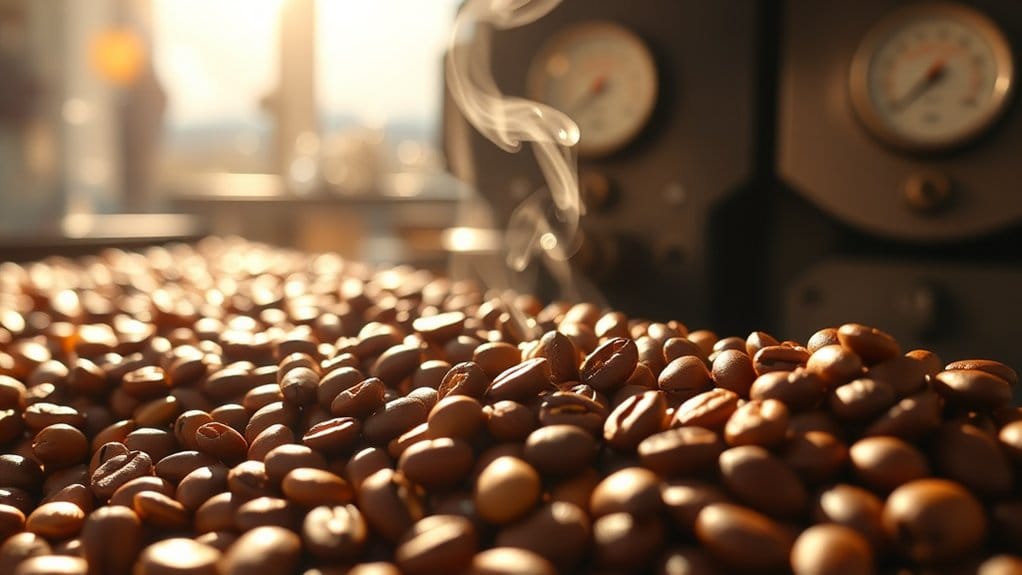
Coffee roasting temperatures are essential for unlocking the rich flavors and aromas in your beans. Higher temperatures can lead to burnt tastes, whereas lower ranges might leave you with underwhelming notes. Ever wonder why some coffees are fruity or chocolatey? That’s the Maillard reaction working its magic! Knowing the right roast levels—light, medium, or dark—leads to incredible brews. Curious about other tips and tricks for roasting like a pro? There’s so much more to investigate!
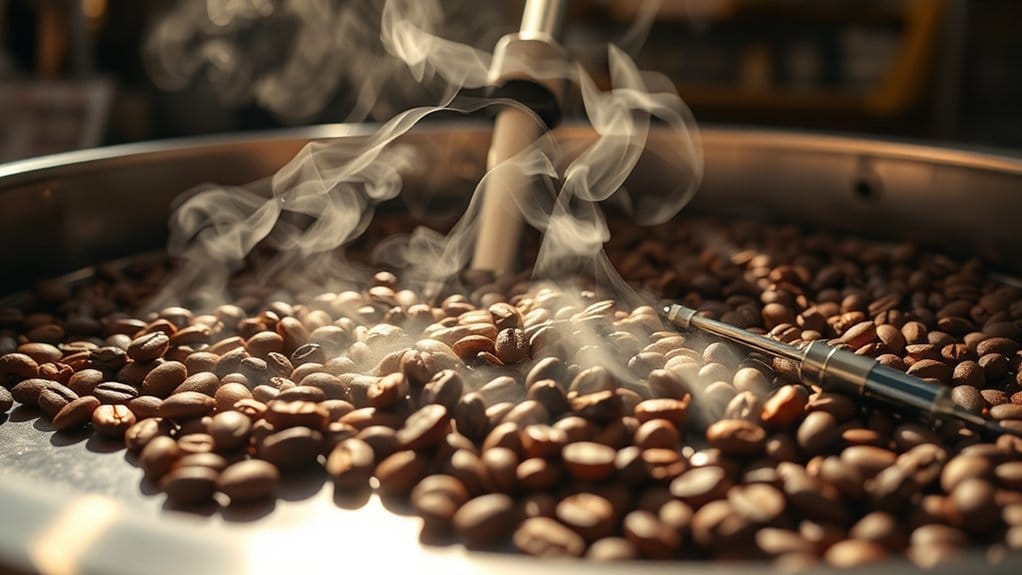
When you think about coffee roasting, you might picture a cozy café filled with the warm aroma of freshly brewed beans. But the magic happens before that!
Temperature plays a crucial role in roasting. It controls humidity, ensuring your beans dry out just right. Too high a heat, and you risk burnt flavors; too low, and they turn underdeveloped. Monitoring the Maillard reaction is essential to achieve the desired flavor profile as it develops complex flavors during roasting. Additionally, the key stages of roasting, including the drying stage, set the foundation for the flavor development of the coffee. Achieving the right balance of temperatures can help preserve the unique bean characteristics that define each coffee variety.
There’s serious chemistry involved—when beans hit around 356°F, caramelization kicks in, adding that sweet, complex flavor you love. Keep in mind that different temperature ranges bring out various tastes.
Light roasts are fruity, whereas dark ones can be intensely bitter. So, whether you’re sipping a gentle brew or a strong espresso, remember: temperatures truly matter!
There’s something magical about the transformation that happens during coffee roasting, and it’s all thanks to a process called the Maillard reaction.
Named after chemist Louis-Camille Maillard, this reaction occurs when heat triggers a choreography between amino acids and sugars.
Imagine your coffee beans, humidity-free and ready, diving into this flavorful party after the drying phase. As temperatures climb between 140°C to 200°C, they brown beautifully, creating complex aromas and tastes. This is where you’ll find notes of chocolate, floral hints, or even earthy undertones. With each roast level—light, medium, or dark—the Maillard reaction shapes your coffee’s unique personality. Understanding the factors influencing this reaction, such as temperature and time, is essential for achieving the best flavor results. Achieving a balance in roasting through the manipulation of the Maillard reaction influences the overall tasting experience of coffee.
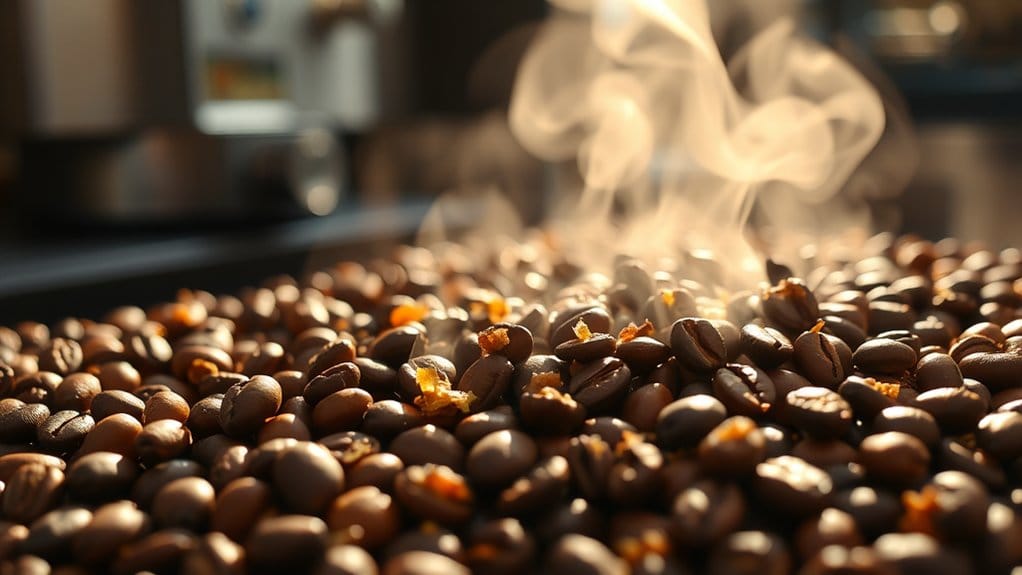
Coffee roasting is a fascinating expedition of flavors where caramelization plays a starring role. As the temperature rises between 170°C and 200°C, sugars start breaking down, leading to delicious transformations. This process is influenced by the conditions under which coffee is grown, including soil health and climate, which can impact the flavor profile of the beans.
You can think of caramelization as the party that brings sweetness and aroma to your cup of coffee. During this process, you’ll notice those rich, warm scents wafting through the air. Plus, prolonged caramelization can smooth out acidity, creating a balanced drink. This phase marks the occurrence of the first crack, where sugars are released, further altering taste and aroma.
Yet, finding the sweet spot is key; overdoing it might lead to muted flavors. So, as you sip your carefully roasted brew, keep in mind that caramelization adds depth and richness, making each cup a delightful experience to savor.
Cheers to that!
Identifying roast levels can feel like a flavorful expedition, as you’ll soon reveal the distinct qualities of light, medium, and dark brews.
Light roasts shine with a light brown color, bright acidity, and fruity notes. They’re like the cheerful morning sun!
Medium roasts offer a cozy balance, showing deeper caramel flavors with some visible oils. Think of them as that warm hug on a chilly day.
Dark roasts? They bring bold, smoky flavors, presenting a very dark sheen, almost like a midnight sky. As you sip, you’ll appreciate those unique tastes and aromas each level provides.
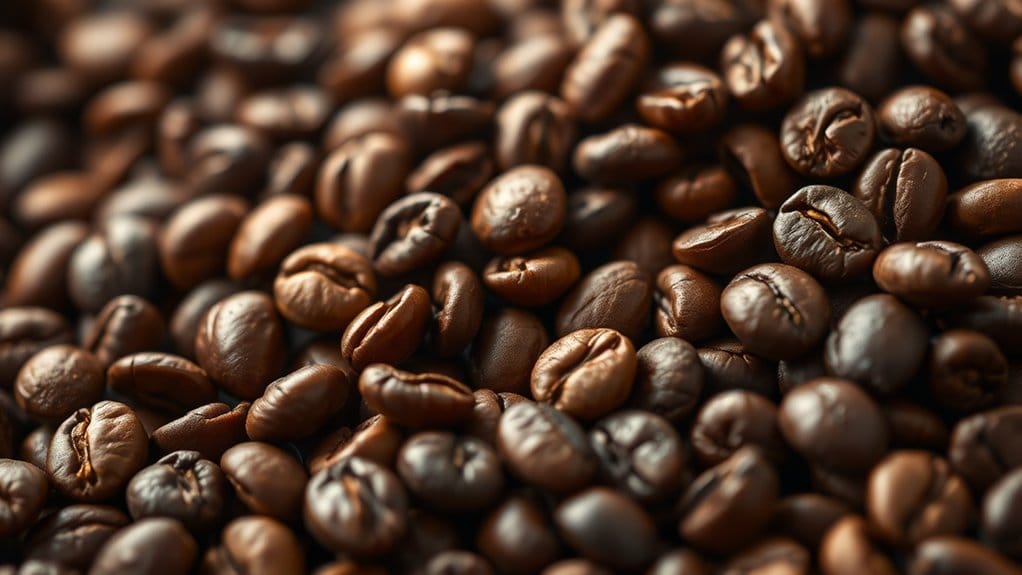
When you heat coffee beans during roasting, fascinating changes occur that impact both their size and color. As the temperature rises, beans expand, gaining volume as they lose humidity.
You might notice that a bag of dark roast coffee looks larger than a light roast of the same weight—thanks to this expansion!
The coloration transforms too, shifting from light tan to dark brown, all because of those intense chemical reactions happening inside. It’s like the beans are putting on a show!
Roasters carefully watch for color changes, ensuring a consistent look. This process creates a delightful, aromatic cup of coffee, as visual and textural elements blend perfectly. Freshly ground coffee emphasizes how crucial these transformations are for enhancing flavor.
Who knew roasting could be such delicious chemistry?
Getting the timing and heat just right is essential for a perfect roast. Imagine tossing those green beans into a hot drum; the initial charge temperature sets the stage. Too low, and you’re left with a flat flavor—yikes! Too high, and you’ve got scorched coffee that tastes like a campfire.
You’ve got to time your heat application carefully. Roasting has phases where you dry, develop, and transform flavors. Each step matters!
Think about it; a light roast takes around 15 minutes, but a dark one speeds up. Keeping an eye on those temperature drops is key—you don’t want to bake that roast. Understanding how roast levels impact flavors can help you achieve the desired profile for your coffee experience.

Every coffee lover knows that the roast level can completely transform your cup.
With light roasts, you’re greeted by bright, fruity notes and a lively acidity that twirls on your tongue. Think citrus zest or a hint of berry!
Medium roasts balance sweetness with nutty and cocoa flavors, giving you a cozy hug in a mug.
Finally, dark roasts step up the drama, wrapping you in rich, smoky notes that feel like a warm fireplace on a chilly evening.
Each level takes you on a flavorful expedition, revealing the bean’s story. For instance, light to medium roasts help preserve natural acidity and minimize bitterness, providing a smoother experience.
So, whether you savor the crispness of light roasts or the boldness of dark, there’s a perfect cup waiting just for you!
What’s your favorite roast?
As you explore the rich world of coffee, understanding how to achieve consistency in roasting becomes just as important as revealing your favorite roast.
Start by managing your burners. Adjust them individually to keep the heat even, preventing those annoying roast disparities. Keep an eye on charge temperatures—too high or low can mess with flavor.
Enjoy roasting larger batches? Remember, they need different heat strategies!
Don’t forget about monitoring those temperatures and roast curves. A steady rate of rise guarantees flavors develop beautifully.
Last but not least, calibrate your equipment regularly. It’s like giving your roaster a little spa day!
With these techniques, you’ll brew up delightful cups every time—no surprises, just pure coffee joy!
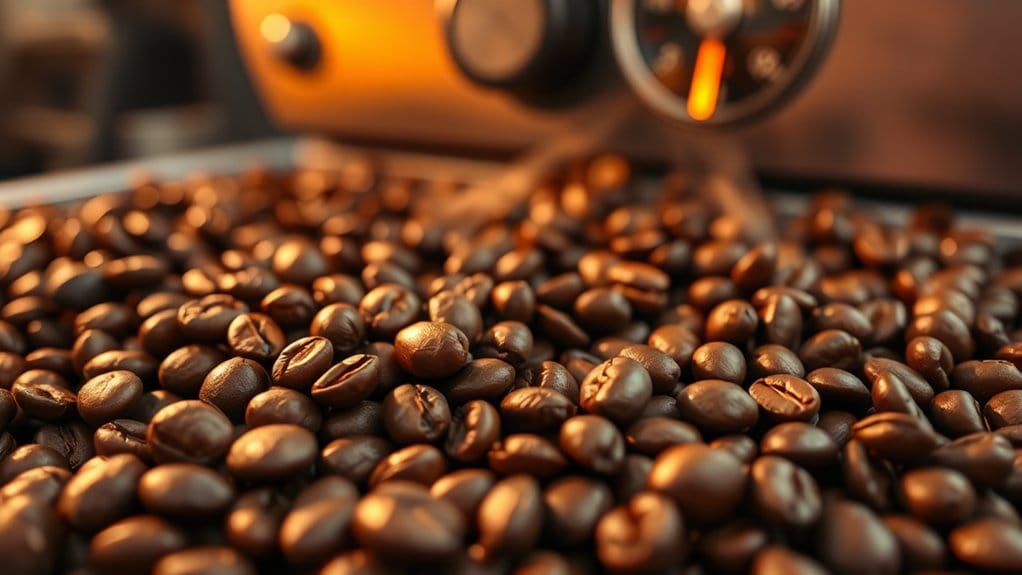
When you plunge into the world of home coffee roasting, understanding the practical aspects can feel like brewing a perfect cup—exciting yet a bit intimidating.
Start by preheating your roaster to around 220°C, but don’t be surprised if the temperature drops when you toss in those green beans! Keep a close eye as the heat rises.
Managing temperature carefully helps develop those delicious flavors. If things heat up too quickly, adjust your heat or airflow to avoid scorching.
And remember, cooling your beans right after roasting is key to locking in that fresh flavor. It’s like a victory lap—don’t skip it!
With these tips, you’ll be on your way to crafting brews that wow your taste buds.
Now that you’ve got a handle on the practical tips for home roasting, let’s explore how to tailor your roasting profiles to the unique types of beans you’re working with.
For instance, if you’re using Arabica beans, a light to medium roast can preserve those bright, fruity notes. At the same time, robusta beans crave a medium-dark roast to smooth out their bitter edges.
Think of it as a flavor choreography—higher elevation Arabicas bloom with floral sweetness, whereas lower elevation robustas need the deep warmth of darker roasts. Additionally, understanding the caffeine content of different beans can help you select the ideal roast level for your desired strength and flavor profile.
And remember, blending different beans can create a delightful harmony, balancing acidity and strength.
Altitude impacts roasting temperatures and flavors considerably. You’ll need to adjust your roasting techniques, as higher altitudes require more heat and can create richer flavors, whereas lower altitudes allow for milder, less complex profiles.
For home coffee roasting, you need crucial equipment like air roasters, drum roasters, and stovetop roasters. Thermometers and cooling trays are important too, ensuring consistent roasting and preserving the flavor of your beans.
Yes, different bean origins definitely influence your roasting temperature decisions. For instance, African beans thrive at higher temps for brightness, whereas Latin American beans prefer lower temps to highlight their sweetness and nutty notes.
Humidity levels greatly impact your coffee roasting outcomes. High humidity slows heat transfer, extending roasting times, whereas low humidity can quicken the process but may risk unevenness, affecting flavor and overall quality. You need to adjust accordingly.
When roasting coffee at home, avoid using poor-quality beans, inconsistent temperatures, or improper storage. Don’t skip preheating your equipment, neglect monitoring, or overlook post-roast resting. These mistakes can ruin your roast and diminish flavor.